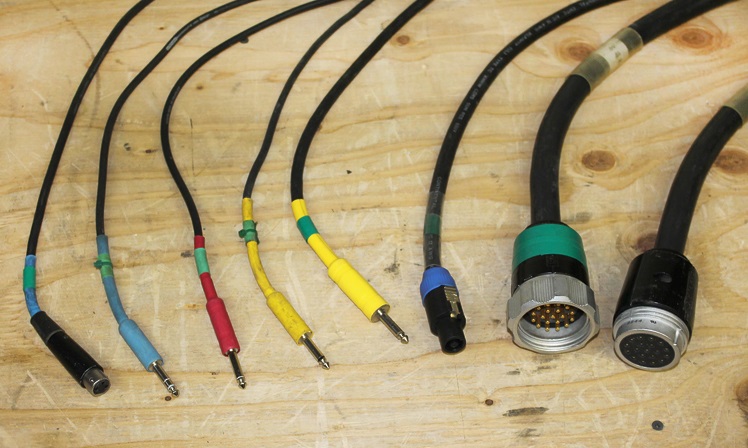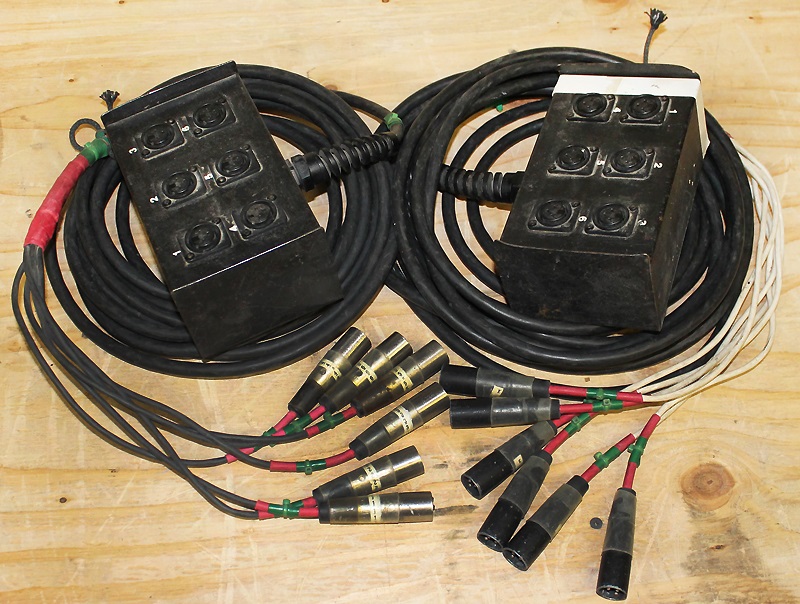
Similar in construction to the XLR is a cable that instead has 3-conductor 1/4-inch phone plugs at each end, usually called a TRS cable. The TRS refers to Tip, Ring, and Sleeve, the three conductor positions on the connector.
These are commonly used as interconnection cables between rack gear and are a popular option for manufacturers who want to use balanced connections but have limited real estate on the product in which to squeeze in XLR connections.
Many consoles have insert jacks that allow patching of external processing into a channel or group. They normally use a TRS 1/4-inch jack and a special Y cable called an “insert cable” that is outfitted with a TRS plug on one end and a 2-conductor 1/4-inch plug at each end of the Y that is used to route to the inputs and outputs of the external processor. The TRS end is usually wired so the tip is the send to the external unit, the ring is the return and the sleeve is the shield or common.
While similar in looks to a TRS cable, a regular 1/4-inch signal cable is quite different. It has only one inner conductor surrounded by a spiral or braided shield. They are used with high-impedance signals from a guitar or keyboard to connect them to a stage amplifier or DI. The outer braid acts as both a conductor and a barrier to help keep RFI and other noises from reaching the center “hot” conductor.
When used with a guitar or other high-impedance input, the cable’s capacitance couples with the high output impedance to create a low-pass filter that varies depending on cable length. The longer the cable, the more highs it rolls off, so 1/4-inch cable runs are usually kept under 25 feet in length unless they’re serving electronic keyboards, which output a hot line-level signal that can drive longer runs.
Another cable that may look identical to these first two is the 1/4-inch loudspeaker cable. While these may have a 1/4-inch plug on each end, the loudspeaker cable is a different animal altogether, designed to move large amounts of output current from an amplifier to a loudspeaker, not the mere milliamps that signal cables handle. Constructed of two heavy-gauge inner-insulated conductors housed in an outer jacket, these cables are commonly used to connect a stage amplifier head to its loudspeaker cabinet, or a small PA loudspeaker to a powered mixer.
Just a reminder—signal cables should never be used for loudspeaker lines, and vice versa. Signal cable isn’t designed to handle high current, and loudspeaker cable is not shielded from outside interference.
Scaling Up
The most popular loudspeaker connector in pro audio is the Speakon (stylized as speakON) from Neutrik. They come in 2-, 4- and 8-pin varieties, allowing a multitude of connections options. The wire size (gauge) of loudspeaker cable depends on a few factors, chiefly the load impedance and the length of the cable. Simply put, the longer the cable, the larger the conductors should be. Common sizes for audio production include 12- and 14-gauge, with a few manufacturers also offering multi-conductor cable in 13-gauge.
Some sound companies deploy an 18-conductor cable with a 19-pin connector called a Socapex, borrowed from the lighting world. These were originally manufactured by Amphenol, but companies like Veam and Kupo also make compatible connectors. Lighting folks use the cable for six circuits of power, while audio folks wire up their systems differently and can get up to nine speaker circuits in one cable. A “Soco to fan out” distributes signal to the various loudspeaker cabinets.

Speaking of multi-circuit cables, snakes are the answer for running multiple channels of audio from one place to another. These cables could have a breakout fan on one or both ends to individual channel lines, or could use a box at one end (usually at the stage end) that individual XLR cables can be plugged into. Snakes can also integrate multi-pin connectors that make it faster and easier to hook up a system. To save weight and size in the cable many snakes use a foil shield around each pair of channel conductors instead of a braided or spiral wrapped shield.
Aside from the obvious stage to FOH mixer application, smaller “stage” snakes are a popular way to help manage cable runs on stage and keep things neat and organized. Another use of snakes is for “crosslink cables” running the signal to the PA system from one side of the stage to the other.
